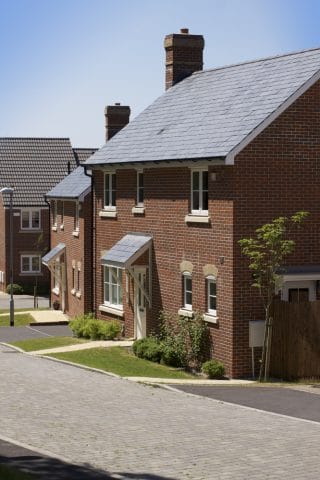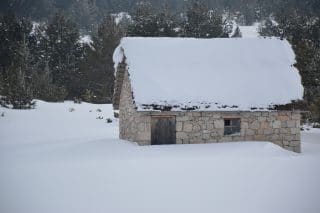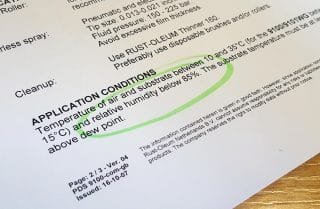When it comes to decorating outside, weather conditions for painting are an obvious important factor to account for. Although it may seem obvious to not start painting outside when it looks like it is about to rain, but what about other weather conditions such as wind or bright sunlight? Read our blog below so your external painting projects are painless and durable.
The Effects of Direct Sunlight
 Avoid painting in direct sunlight. Sunny conditions may be ideal as a contractor outside, but direct sunlight can cause paint to dry far too quickly. We often hear customers protest – surely you want the paint to dry quickly! To understand why paint drying fast is an issue, you will need an understanding of how paint works. Typically, in order to adhere properly to the substrate, paint requires to soak onto the surface to absorb properly. You will find if the paint doesn’t have a chance to fully adhere any paint or coating is at risk of failing.
Avoid painting in direct sunlight. Sunny conditions may be ideal as a contractor outside, but direct sunlight can cause paint to dry far too quickly. We often hear customers protest – surely you want the paint to dry quickly! To understand why paint drying fast is an issue, you will need an understanding of how paint works. Typically, in order to adhere properly to the substrate, paint requires to soak onto the surface to absorb properly. You will find if the paint doesn’t have a chance to fully adhere any paint or coating is at risk of failing.
If you are looking to paint in the Summer it is important to realise the sun can work against your plans. This is vital for understanding the ideal weather conditions for painting. If you notice that the substrate is warm to the touch from the effects of direct sunlight, it would be better to paint external areas during the early hours of the day before the surface has a chance to become warm.
The Effects of Wind
 Painting externally in windy conditions can lead to the binding agent – solvents or water – to evaporate too quickly. Just like the effects of direct sunlight this can lead to the paint not having enough time to adhere to the substrate correctly. You will notice that regardless of how warm it is, people will still put their washing out to dry. Hand dryers also aren’t particularly warm, yet they still dry your hands. This is why windy weather can prevent your paint from adhering properly.
Painting externally in windy conditions can lead to the binding agent – solvents or water – to evaporate too quickly. Just like the effects of direct sunlight this can lead to the paint not having enough time to adhere to the substrate correctly. You will notice that regardless of how warm it is, people will still put their washing out to dry. Hand dryers also aren’t particularly warm, yet they still dry your hands. This is why windy weather can prevent your paint from adhering properly.
Also, if you are painting in wind, there is the risk of sediment being blown into the wet coating!
The Effects of High Temperatures
Usually with high temperatures in the UK comes high humidity levels. Humidity is the percentage of water in the air. Humidity affects the drying of paint regardless of the suspension liquid within the formulation. When humidity is high, the paint is exposed to a greater amount of water vapor. With more moisture in the air, it takes longer for the water or solvents within the paint to evaporate.
Manufacturers of industrial paints will always provide a product data sheet. This will advise on the highest level of relative humidity, at which you can apply that the paint. We advise, that before commencing any painting job please consult the safety data sheets on our website.
With products such as road line marking paint or thermoplastic, warm road surfaces prevent new line marking from sufficiently attaching to the tarmac or concrete. In order to apply these types of products, the substrate must be properly cooled to allow for proper application.
The Effects of Low Temperatures
 Cold weather in the UK often brings high relative humidity that affects certain paints. If paints are based on natural oils and resins, at low temperatures the paint can become more viscous. This means that when painting in cold weather, or even at sub-zero temperatures, some paints will become very thick or semi-solid. However, latex paints will freeze at low temperatures.
Cold weather in the UK often brings high relative humidity that affects certain paints. If paints are based on natural oils and resins, at low temperatures the paint can become more viscous. This means that when painting in cold weather, or even at sub-zero temperatures, some paints will become very thick or semi-solid. However, latex paints will freeze at low temperatures.
If you have no option than painting at cold temperatures, issues can arise such as improper film build up, poor colour uniformity, higher mixing time and excessive film build up leading to an increased coverage rate.
Depending on the product, some types of paint require specific storage conditions to negate the effects of excessive hot or cold temperatures. We suggest if painting in low temperatures is unavoidable, the paint container could be sat inside a larger container such as a bucket filled with hot water to bring the temperature of the paint up. The paint will need to be continually stirred to spread the heat from the water throughout the paint.
 Some manufacturers provide paint specifically formulated for cold conditions. These are typically identified with the suffix WG – Winter Grade or LT – Low Temperature. These are perfect for exposed areas such as bridges, buildings at excessively cold temperatures, the food industry or for cold storage uses.
Some manufacturers provide paint specifically formulated for cold conditions. These are typically identified with the suffix WG – Winter Grade or LT – Low Temperature. These are perfect for exposed areas such as bridges, buildings at excessively cold temperatures, the food industry or for cold storage uses.
The Effects of Rain
Even though it seems obvious, hoping for the best and painting externally with the risk of rain can be a costly mistake to make. Contractors looking to rush a job, or end users with little knowledge can be at the bad end of a downpour causing a messy expensive disaster. Not only will your paint be wasted, contractors time will be increased due to clear up and other materials externally can be effected by drips.
It is important to keep an eye on a variety weather reports to ensure the time pencilled in for painting is not only perfect for contractors but perfect weather conditions for painting.
The Effects of Dew Point
The dew point is the temperature to which the air must be cooled to convert the moisture present in the atmosphere from a vapour to a liquid. This liquid can be seen on surfaces in the form of condensation water droplets. A higher dew point means there will be a higher content of moisture present in the air. When painting, it is important to ensure the substrate temperature is a minimum of 3 degrees Celsius above the dew point. This is to ensure no condensation will form on the surface and compromise the paint coating during application.
Moisture can have a negative effect on both solvent and water based paints. Solvent based paints can be subject to blooming and blistering. This is due to a reaction between the water and solvents present in the paint. With water based paints this water will act as paint thinner. This can cause the paint wash off the surface.
Conclusion: The Ideal Painting Weather Conditions
- Ideal air temperature of between 12oC and 35oC*
- Overcast cloudy conditions
- No risk of rain during the application and drying period
- Maximum of 80% Humidity
- The substrate must be a minimum of 3oC above the dew point
*As each paint or coating is formulated for different situations, environments and weather conditions for painting. The above ideal conditions may be incorrect for specific paints. As standard, Promain recommend a thorough reading of individual product technical and safety data sheets prior to purchase or application.
Have any queries about specific paints or weather conditions for painting required? Contact our technical team on 01462 421333. Our technical team receive regular manufacturer training, ensuring that you receive the correct knowledge for your individual paint and circumstance.

